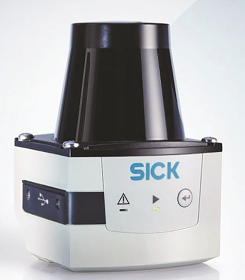

A SICK Automation LiDAR sensor was used to build a winning robotic platform in the prestigious Drexel University’s annual College of Engineering senior project design competition. For the Swerve team, the process was invaluable for learning how to create something innovative that works.
Freddy Wachter (mechanical engineering), Alexander Nhan (electrical and computer engineering), Harrison Katz (mechanical engineering) and Matt Wiese (mechanical engineering) set out to design and build a robotic platform. There was a lot of trial and error, testing and collaboration among the Swerve team during the project which was taken over a class over three 10-week quarters of the 2017/2018 school year.
Among eight teams who competed, the first-place result was the Swerve Robotic Platform, a highly versatile, three-wheeled, autonomy-enabled vehicle that is capable of carrying large loads while moving at high speeds and accelerations. Swerve was designed, fabricated and tested using motion-capture systems, advanced machining, computer simulations and software, as well as SICK’s LiDAR sensor.
While Swerve might look like a triangle on wheels with a lot of wires on it, the innovation lies in four design elements which the team packed into one robotic platform.
“Robotic mobility platforms today contain just a couple of the elements of lightweight, high-speed, omni-directional and integrated technology, but Swerve incorporates all four,” says Wachter. “Such elements make Swerve innovative, surpassing the functionality of many similar platforms. For starters, Swerve weighs less and carries more than similar robots.
Sensor technology
Sensors were a key technological element of Swerve’s design to support navigation, autonomy and nimbleness. The swerve uses SICK Automation’s 2D LiDAR (light detection and tanging sensors for area-monitoring data capture, and IMU (inertial measurement unit) sensors. The Swerve robot receives the LiDAR data through a SICK TiM561 sensor, which provides scan angles and ranges to the nearest object to those angles. These scans can then be visualised and used to create 2D representations of the robot’s local environment.
Wachter credits SICK’s enthusiasm for the project from a connection that came about from his attendance at a robotics conference, ROSCon 2017, in Vancouver. There, he connected with a SICK West Coast executive who connected him to George Thiel, SICK account executive for the northeast region.
Mechanical elements of swerve
A number of mechanical and structural elements make Swerve nimble, fast and omni-directional. “It has caster wheels that can rotate in every direction and uses slip rings to keep all the wires tangle-free,” Wachter says. This means wheels can move independently and turn on a dime. Brushless DC motors allow the vehicle to accelerate quickly.
Many of the mechanical design elements of the Swerve impressed the project judges. “The major part of what helped us win the competition was in-depth design which was described well in our report,” says Wachter. Elements like welded crush tubes built into the aluminium chassis gave Swerve the strength to withstand heavy loads.
Swerve gets a life
The Swerve team had a strong idea going into the project, based on a request and sponsorship from a former co-worker – Josh Geating, project stakeholder and robotic tinkerer. Geating contributed design input and will potentially use Swerve to compete in BattleBots competitions in California.
Geating underscored how the team designed the platform with the human-machine interface in mind. “Project Swerve is an attempt to make the most agile robotics wheeled platform to date while maintaining a high level of precision and sensing to enable autonomy and highly dynamic motion,” says Geating. “Power, precision and mass are often mutually exclusive in robotics, and the combination of these three in the Swerve platform enables many unique applications.”
While Swerve may live on in BattleBot applications for now, future uses abound. In addition, personal mobility uses for Swerve include serving the disabled. Entertainment and amusement applications include serving as a base for trackless rides, allowing for easily changing the consumer experience without building a whole new attraction.
The logistics industry already has companies like Amazon deploying robots in the warehouse for picking orders. Swerve could supplement a warehouse labour force to meet peak demand periods or work every day. “Swerve has potential to work alongside warehouse personnel in a dynamic environment,” explains Wachter.
Indeed, the Swerve platform holds the potential to incorporate machine learning (ML) and artificial intelligence (AI). “The framework we used would allow the opportunity for ML and AI to be used,” concludes Wachter. “Though it would take a significant amount of time to develop customer-specific applications, it can be done.”
For more information contact Mark Madeley, SICK Automation Southern Africa, +27 10 060 0550, [email protected], www.sickautomation.co.za
| Tel: | +27 10 060 0550 |
| Email: | [email protected] |
| www: | www.sick.com/za/en/ |
| Articles: | More information and articles about SICK Automation Southern Africa |

© Technews Publishing (Pty) Ltd | All Rights Reserved